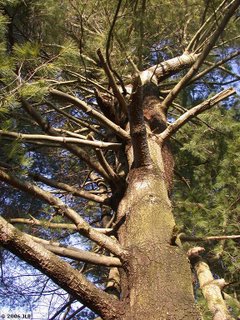Mystery Evergreen Tree
Good morning and happy Monday everyone!
As promised, this week we’ll be looking at an as-yet-unknown evergreen tree. There are actually a few of them around me, but we’ll investigate a couple in particular which you can see alongside my cottage in the Friday, January 27, 2006 entry. These evergreens, while appearing to me to be some type of pine (based on needles and cones), are unique in their overall growth pattern from other evergreens I know.
What I know
In my experience, most evergreens grow in some sort of conical, tapering pattern. There is typically a single trunk (unless there was a split somewhere in the tree’s history, which sometimes results in two main trunks). From this single trunk one usually sees branches of progressively younger generations as one heads towards the crown, resulting in the standard conical shape. Deviations from this shape often include bent tops, disproportionate sides, or the die-back of lower branches leaving most of the greenery near the top of the tree. Western red cedars also appear to have multiple trunks on occasion.
What I see
The evergreen trees beside my cottage are completely different. There appears to be one primary trunk at the ground level which diverges around 1.5 meters from the ground. At that point it becomes several branching trunks, all of which curve up vertically to parallel what appears to be the original trunk. The branches do not follow the standard pattern with which I am familiar, but rather appear to break off and resprout much like you might see in a Big-leaf maple tree.
At first, I thought this was the result of some strange pruning… but after this last windstorm, I’m rather convinced that it is the natural growth habit for this species. Why? Because during the storm, the tree cast numerous branches, some of them large, to the ground. I can clearly see where new branches are likely to resprout, continuing the somewhat random growth pattern seen in this image. I can also see that what originally appeared to be a major hack job on behalf of the gardener is in fact more likely to be the natural loss of branches in previous years.
As seen in last Friday’s entry, the over-all outer shape of the tree is indeed semi-conical and somewhat tapering… but when you look up their skirts, there is an entirely different story in these trees.
Are these trees simply some type of White pine with a rather unique history, or are they an entirely different species? Conjecture is welcome, as are questions.


 Follow Jade Blackwater on Twitter
Follow Jade Blackwater on Twitter


Looks like those branches are sturdy enough to climb up.
ReplyDeleteI've definitely been thinking about it ever since we moved in... Even the lowest branches would make nice perches for a change in perspective! :)
ReplyDelete